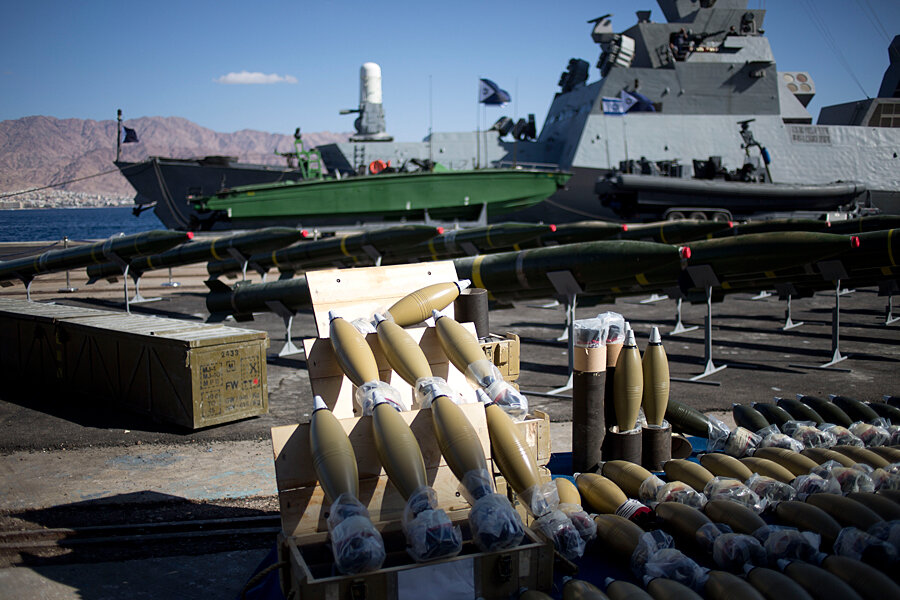Israel: Seized rockets would put Jerusalem in Gaza's range
| Jerusalem
Israel pulled out all the stops today to unveil the loot found on the Klos-C cargo ship, which it claims was carrying a large shipment of Iranian-supplied weapons destined for terrorist groups in the Gaza Strip.
Israeli Prime Minister Benjamin Netanyahu, Defense Minister Moshe Yaalon, and Israel Defense Forces (IDF) Chief of Staff Lt. Gen. Benny Gantz all personally addressed foreign reporters in Eilat, the Red Sea port where Israel brought the ship to land.
Here are the main weapons that Israel revealed from the shipment:
M-302 rockets: The IDF reported finding 40 Syrian-made M-302 rockets, which were first developed in the 1990s. They now come in five different variations known as A, B, C, D, and E, with E offering the greatest capability in terms of range and payload, Israel’s Ynet news outlet reported last week. During Hezbollah’s last major conflict with Israel, it primarily used the A and B versions of the rocket, which have a range of 56 to 72 miles. But the M-302 rockets that Israel found aboard the Klos-C have a greater range – 55 to 100 miles – which would have significantly boosted the capability of Gaza terrorist groups, putting nearly all of Israel’s major population centers within range, including Jerusalem, Tel Aviv, and Haifa, as well as the country’s main airport. [See map]
Mortar shells: The IDF also found 181 120-mm mortar shells, similar to the heavy mortars that Gaza militant groups have been sending over the Gaza border into southern Israel for years. These mortars, therefore, were significant not so much for their type as for the quantity found.
Bullets: The last of three weapons identified by the IDF were 400,000 7.62-mm caliber bullets. Such bullets are frequently used in Kalashnikovs, a common weapon for Hamas policemen in Gaza. Kalashnikovs, alternatively known as AK-47s, were also used by the militants who launched a cross-border attack on Israel from Sinai in August 2011.
The Israeli navy intercepted the ship last week in the Red Sea, adding heft to the chorus of calls from Jewish and Israeli leaders at the annual American-Israel Public Affairs Committee (AIPAC) conference in Washington to keep up pressure on Iran until it comes clean on its nuclear program.
The same day the IDF intercepted the ship, it released a video in English illustrating the weapons' path from a manufacturing facility in Syria to the Red Sea. Had the shipment not been seized, it claimed, the weapons would have been unloaded in Sudan and brought overland through Egypt to Gaza.
Iran’s role in supplying weapons to terrorist organizations on Israel’s borders has not deterred Washington from pursuing negotiations with Iran, against protests from Israel that the smiles of Iranian President Hassan Rouhani and Foreign Minister Mohammad Javad Zarif cannot be trusted.
"The world needs to awaken from its state of illusion and prevent Iran from acquiring the capability to create nuclear weapons," Mr. Netanyahu said at the press conference. "The international community's decision to ignore the seized weapons ship is biased, dangerous, and unacceptable."
Netanyahu stressed at the Eilat press conference today that the discovery of these weapons should be taken more seriously by the international community.
"I heard only isolated and weak condemnation of Iran from the international community regarding this deadly shipment," he said. "By contrast, we are witness to smiles and handshakes of representatives of the West with the representatives of Iran in Tehran at the very time that these missiles were being unloaded in Eilat.”
While Israeli claims about the Klos-C have been met with some skepticism, Israeli forces have been known to intercept other Iranian-supplied weapons shipments to Gaza before, including the Victoria in March 2011, the Francop in November 2009, and the Karine A in 2002. Still, there are a number of unanswered questions, including how the M-302 rockets would have been smuggled into Gaza, given Egypt's recent crackdown on the smuggling tunnels.






